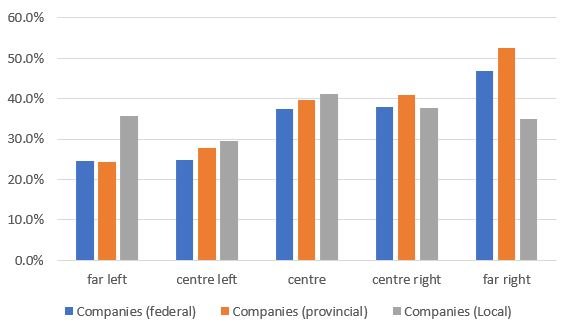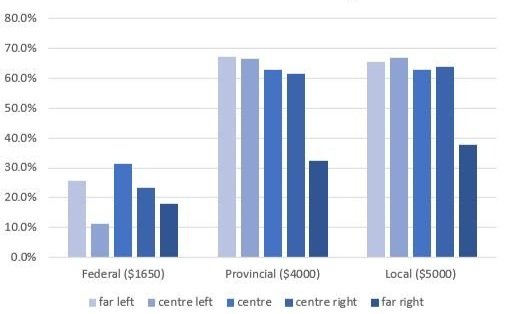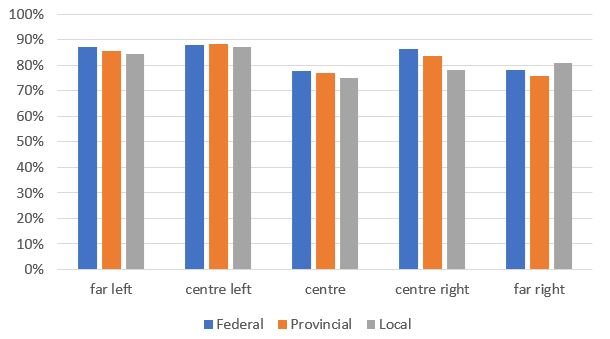Albertans’ Views about Money in Politics
Jared Wesley | University of Alberta | jwesley@ualberta.ca
Lisa Young | University of Calgary | lisa.young@ucalgary.ca
January 31, 2022
Money is essential to electoral democracy. Political parties and candidates need to have access to resources so that they can communicate with potential voters. But the ways that they raise that money, and how much they can spend, are important issues. In a democracy, it is essential that the public feel confident that rules governing money in politics protect the integrity of the political system.
In the context of electoral politics, there is potential for money to buy political influence. To avoid this, and even the perception that it might occur, governments have adopted rules limiting who can make political contributions and how large they can be. To promote fairness in competition, governments have adopted rules limiting how much parties and candidates can spend during elections. And to ensure that parties and candidates’ voices are not drowned out at election time, or that organizations that want to exercise influence cannot evade other rules, governments have limited how much organizations other than parties and candidates (“Third Party Advertisers”) can spend during elections.
What do Albertans think about these questions? Do their views align with the rules currently in place? And, in Alberta’s charged political landscape, does political ideology shape their views?
Background
Until 2015, Alberta’s provincial election finance rules were quite lenient, allowing individuals, corporations and unions to make political contributions to parties and candidates, with an annual maximum of $15,000, or $30,000 in election years. There were no limits on how much parties could spend during elections. The rules for municipal elections were slightly more restrictive, limiting contributions to $5000.
The Notley government changed the rules for both provincial and municipal elections. These reforms brought Alberta in line with most other provinces and the federal government by allowing only individuals to make contributions to parties and candidates, effectively banning contributions from unions and corporations. The changes also limited the maximum contribution amount to just over $4000. The Notley government’s reforms also established a limit on how much provincial candidates and political parties could spend in elections, once again making Alberta’s rules more similar to those found elsewhere in Canada.
The Kenney government has introduced two major sets of changes to election finance: one for municipal elections and the other for provincial elections. Both made changes to the rules governing Third Party Advertisers. A significant change to the Local Authorities Elections Act increased the maximum contribution to municipal candidates from $4000 to $5000.
Who should be allowed to contribute?
Over the past twenty years, election finance rules in most Canadian jurisdictions have changed to make individuals the only legal source of contributions for candidates and political parties. Unions and corporations can make contributions to or register as Third Party Advertisers in elections in many of these jurisdictions, but they cannot contribute directly to parties or candidates. Although corporate and union contributions historically played an important role in financing parties and candidates, a growing sense that these contributions created opportunities for undue influence on political decision-makers resulted in reforms.
Figure 1 – Who Should be Able to Donate to Campaigns, by Level of Government
Source: Viewpoint Alberta Survey October 2021 (N=1204). Weighted data. Figures correspond to respondents’ answers to the question: “Who do you think should be allowed to donate to candidates in federal, provincial or local elections? Select if you think the donor should be permitted. … Yes / No”
Figure 1 shows that most respondents believed citizens should be allowed to make political contributions (although 1 in 10 did not). Support for allowing permanent residents to contribute was lower, with only 6 in 10 supporting the idea. This difference signifies a belief that the ability to contribute should correspond with the right to vote.
This is even more evident when we look at how many respondents agree that “outsiders” should be permitted to contribute at any level of government. At the federal level, “outsiders” were people from outside Canada; at the provincial level, from outside Alberta; and at the municipal level, from outside the municipality. The strongest opposition to outsider donations was at the federal level, with 77% disagreeing/strongly disagreeing. This was slightly less (73%) at the provincial level, and lower still at the local level (67%). Even so, at all levels the majority of respondents disagreed with the idea of individuals from outside the jurisdiction being permitted to contribute.
Even though contributions from corporations, unions and interest groups have been prohibited in federal politics since 2004, and in Alberta politics since 2015, there was still some support for permitting these organizations to make donations. One-third of respondents indicated it would be acceptable for unions and corporations to contribute directly to parties and candidates. As Figure 2 shows, these views vary somewhat by political ideology, which we measured by respondents’ self-placement on a 10-point spectrum. Those on the far left are inclined to consider contributions from companies and interest groups unacceptable, but are more favorable to allowing contributions from unions. Those on the far right are more favorable to allowing corporate contributions, but also to permitting union and interest group contributions. This suggests those on the right side of the spectrum are more reluctant to regulate contributions, regardless of source.
Figure 2: Who Should be Able to Contribute, by Ideology.
Source: Viewpoint Alberta Survey October 2021 (N=1204). Weighted data. Figures correspond to respondents’ answers to the question: “Who do you think should be allowed to donate to candidates in federal, provincial or local elections?” Respondents were asked to place themselves on an ideological spectrum ranging from 0 (far left) to 10 (far right). We coded 0 to 1 as far left; 2 to 4 as centre left; 5 as centre; 6 to 8 as centre right; and 9 to 10 as far right.
How much should donors be allowed to give?
Even with restrictions in place on who can make contributions, concerns remain that relatively large contributions to candidates or parties might allow the donor to exercise undue influence on the politician, once elected.
Alberta’s donation limits are high relative to most other provinces and the federal government. The limit for municipal candidates is particularly high. Changes to the Local Authorities Elections Act in 2020 increased the maximum amount of contributions to candidates running for municipal office to $5000, and allowed an individual to give that amount to an unlimited number of candidates. These rules are substantially less restrictive than those governing other major Canadian cities. The maximum contribution allowed in Vancouver is $2400; $1200 for Council and $2400 for Mayor in Toronto, and only $100 in Montreal. All of these jurisdictions also have global limits for contributions in a year, while the Alberta legislation allows contributions of up to $5000 to every candidate.
The majority of respondents (69%) thought that the federal donation limit of $1650 was “about right” and another 23% thought it was too high. In contrast, just over 60% thought the provincial ($4000) and municipal ($5000) limits were too high, and only 36% thought they were about right. (Figure 3)
As Figure 4 shows, this view is largely independent of political ideology, except for those respondents who place themselves at the far right of the political spectrum. Figure 5 shows that there are meaningful differences between urban, suburban and rural Albertans in their assessment of these limits, with those living in rural areas the most inclined to see the limits as “too high.”
Figure 3 - Impression of Donation Limit, by Level of Government
Source: Viewpoint Alberta Survey October 2021 (N=1204). Weighted data. Figures correspond to respondents’ answers to the question: “Below, we list the maximum amount that an individual can donate to a candidate or political party for federal, provincial or local elections. Please tell us whether you think this amount is too low, too high, or about right.”
Figure 4: Contribution Limits “too high” by Ideology
Figure 5: Contribution Limits “too high” by Residence
Importance of Regulating Political Finance
When asked about how important different campaign finance rules were, there was very little variation across type of restriction or level of government. The only one that stood out was donation limits for provincial politics: 91% of respondents indicated these were somewhat or very important, as compared to only 80% and 78% for federal and municipal elections, respectively. There were few differences by ideology.
Figure 6: Importance of Spending Limits for Candidates by Ideology
Source: Viewpoint Alberta Survey October 2021 (N=1204). Weighted data. Figures correspond to respondents’ answers to the question: “How important is it to have limits on how much money a candidate can spend on their campaigns at each of the following levels?”
One of the issues that has come under some scrutiny in recent Alberta elections is the role of “Third Party Advertisers.” These are organizations - which can include unions, corporations and interest groups – that spend money to advertise in favor or in opposition to a candidate or political party during a campaign. Limits on third party advertising have been controversial in Canada over the past thirty years, sparking several constitutional challenges to legislation that limited the ability of these organizations to spend during election campaigns. At present, there are limits on how much third parties can spend in federal elections and Alberta provincial elections, but no limits at the municipal level (although the Local Authorities Elections Act does allow the Minister to impose such limits via regulation).
Figure 7 shows that there is support for limiting Third Party Advertisers’ spending across the political spectrum, and at all levels of government.
Figure 7: Importance of Limiting Third Party Spending by Ideology
Source: Viewpoint Alberta Survey October 2021 (N=1204). Weighted data. Figures correspond to respondents’ answers to the question: “How important is it to have limits on how much money third parties (e.g., businesses, unions, interest groups) can spend on political advertisements during federal, provincial, and municipal election campaigns?”
Disclosing the names of donors to candidates and political parties is a central element of the rules governing political finance in Canadian jurisdictions. Donors names are published annually, and several months after an election. Respondents were asked how important it was that this disclosure occur before the election. The majority indicated that they thought it was either somewhat or very important, across all three levels of government: 85% for federal and provincial elections, and 83% for municipal elections. Figure 8 shows modest differences across the ideological spectrum, with those on the left more likely to consider pre-writ disclosure important.
Figure 8: Importance of Disclosure by Ideology
Source: Viewpoint Alberta Survey October 2021 (N=1204). Weighted data. Figures correspond to respondents’ answers to the question, “How important is it that candidates for federal, provincial, or municipal office disclose the names of people and groups that have donated money to their campaigns prior to election day?”
Conclusion
The findings of the Viewpoint Alberta survey tell us that the majority of Albertans are comfortable with, and place importance on, the regulation of money in politics. When asked how important it is to have rules that govern various aspects of political finance, a sizable majority say that it is important. And these views do not vary substantially across the political spectrum.
The attitudes measured by this survey are generally supportive of the rules currently in place at the federal, provincial and local level. A substantial majority support the rules that allow only individuals to contribute, and there is strong support for banning “outsiders” at every level. Only a minority think that corporations, unions or interest groups should be able to contribute. On this issue, we find some differences across the political spectrum, with those on the left more likely to think unions should be able to contribute, and those on the right more likely to think corporations, interest groups and even unions should be able to contribute.
One issue on which attitudes measured in the survey were not consistent with the rules in place is the restriction on the size of contributions. Here, a majority indicate that Alberta’s limits for contributions to provincial and municipal candidates are too high, suggesting dissatisfaction with the most recent increase to donation ceilings for local elections. With the exception of those at the far right of the political spectrum, ideological differences are muted.
The consistency between attitudes measured in this survey and the rules in place, and the general consensus across the ideological spectrum are positive indicators in what is often a polarized political landscape. They suggest that the electorate sees the broad framework of election finance rules as appropriate and legitimate. General agreement and support for the current system stand in contrast to views about the specific size of contribution that are allowed. This is an area in which the rules are not consistent with public views, and warrant reconsideration.
Methodology of the Viewpoint Alberta Survey
The September 2021 Viewpoint Alberta Survey was conducted between September 21 and October 6, 2021. The survey was deployed online by Leger. A copy of the survey questions can be found here: https://bit.ly/2YEMObS. Leger co-ordinates the survey with an online panel system that targets registered panelists that meet the demographic criteria for the survey. Survey data are based on 1204 responses with a 17-minute average completion time. This wave of the Viewpoint Alberta Survey was led by co-principal investigators Jared Wesley, Michelle Maroto, Feodor Snagovsky, and Lisa Young. It was funded in part by a Research Cluster Grant from the Kule Institute for Advanced Study (KIAS) at the University of Alberta.










